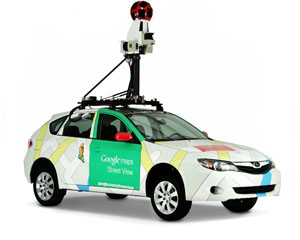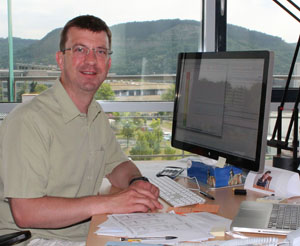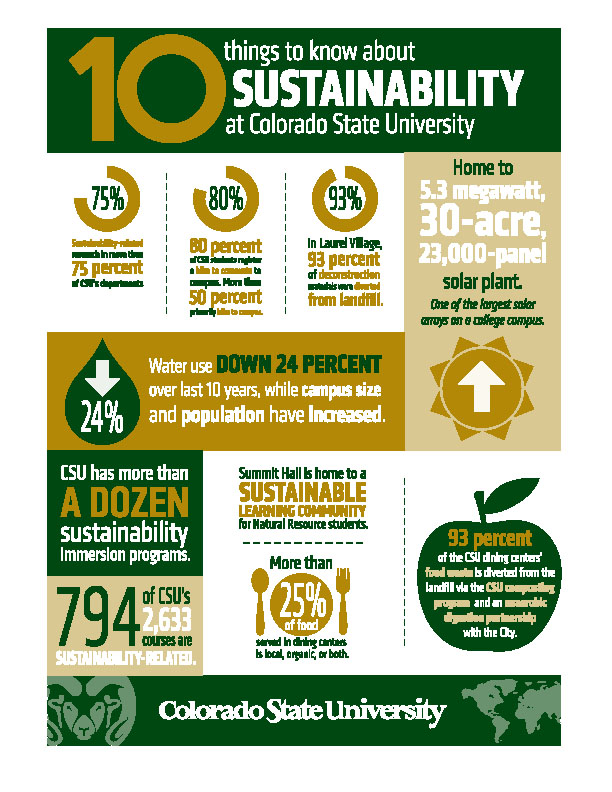Join your friends for ‘Rams at the Rio’
Two Colorado institutions – Colorado State University and Rio Grande restaurants – are partnering to bring great football and great food and drinks together on game days.
Two Colorado institutions – Colorado State University and Rio Grande restaurants – are partnering to bring great football and great food and drinks together on game days.
In August 2014, nearly 130 of the world's best professional cyclists stormed through Colorado for a seven-day stage race -- the USA Pro Challenge -- and CSU was part of the action and worldwide spotlight.
Melissa Reynolds’ quest to develop implantable medical devices that the human body will not reject has received a $500,000 boost from the National Science Foundation.
A dozen student companies are in the Institute for Entrepreneurship’s program this fall.
The viral spread of smartphones has jumped a species. African elephants are now also benefiting, thanks to new software algorithms developed by researchers and conservationists.
Accidental poisoning is among the most common problems seen in emergency veterinary medicine. Learn what you can and can't feed your pet.
Gamers use good grammar? Surprising as it might sound, that's one the findings from studies of online gaming chat led by a CSU researcher.
The studies found that millennials – notorious for misused language and sloppy typing – are actually more accomplished communicators than many of us believed.
“Online chat – especially in games – is often thought of as eroding the typing and self-expression skills of younger people, but our study shows that they are very expressive and do pay attention to how they communicate both with text and non-verbally with their avatars,” said Rosa Mikeal Martey, the study’s lead author and a professor in Colorado State University’s Department of Journalism and Technical Communication.
Multi-tiered studyThe studies, conducted by researchers at CSU, Syracuse University, Concordia University and the University at Albany, analyzed the chat, movement and appearance of 201 participants as they played a custom-built quest game in Second Life — a 3D virtual world where users can design their own environments and avatars. A follow-up study compared these findings to 375 players of the multiplayer online game World of Warcraft. The studies set out to see if people’s age is revealed in how they communicate and interact.
The study’s Second Life participants ranged in age from 18 to 64 with an average age of 37, and World of Warcraft participants were between 18 and 54 with an average age of 29. Their appearance, movement, chat and mouse clicks were recorded as they played a two-hour quest game designed by the researchers in each world.
Gamers looking for clues“People often have a sense of how old other people are after spending time with them online, even if they’ve never met offline – they notice things like how polite people are, their language use and how they express themselves,” said Martey, who became an accomplished World of Warcraft player before immersing herself in the gaming study.
“It’s not just what people say, it’s the types of phrases they use and how they visually interact in virtual space that serve as cues about people’s age online,” says study co-author Jennifer Stromer-Galley, a professor at the School of Information Studies at Syracuse.
Age differences notedThe researchers found that in both Second Life and World of Warcraft, older players were more polite and less emotionally expressive than younger players. In Second Life, older players also used avatars that were more stereotypically attractive than younger players and about half the number of emoticons. In World of Warcraft, younger players jumped about twice as much, moved around 15% more and moved backwards 30% more than older ones.
“As we found in in our studies of gender, movement reveals a lot about people online – in fact, if you combine gender and age, you see even more clearly that the ones who jump, move backward, and wander around more are most likely to be men under 30,” Martey explained. “Younger players are taking full advantage of the expressive possibilities of the avatar, not just chat – they use that digital self to express themselves just as much if not more than they use words.”
Authors of the study include: Rosa Mikeal Martey, Colorado State University; Jennifer Stromer-Galley, Syracuse University; Mia Consalvo, Concordia University; Jingsi Wu, Hofstra University; Jaime Banks, University of Toronto; Mississauga Tomek Strzalkowski, University at Albany.
 For the past year, Google Street View cars roaming Indianapolis, Boston and New York's Staten Island have captured more than just images. With the help of a Colorado State University team led by Professor Joe von Fischer, the vehicles also measured where and how much methane is leaking from the miles of underground pipelines that deliver natural gas to customers in those cities.
For the past year, Google Street View cars roaming Indianapolis, Boston and New York's Staten Island have captured more than just images. With the help of a Colorado State University team led by Professor Joe von Fischer, the vehicles also measured where and how much methane is leaking from the miles of underground pipelines that deliver natural gas to customers in those cities.
The CSU team helped develop the routes the Google cars drove, and the sophisticated data analysis tools to interpret those methane measures for the project, which is being led by the Environmental Defense Fund.
EDF used the data collected from more than 15 million data points to create interactive maps that depict the thousands of leaks beneath the streets of the three cities. “This complex project started with a rather simple question: can we map and quantify methane leaks in an urban environment?” said von Fischer, an associate professor of biology at CSU. “Researchers, including me, have measured methane concentrations in cities before. The challenge has been the ability to translate methane concentration into understandable leak rate estimates. This effort not only makes a significant scientific advancement, it helps raise awareness of how much methane is escaping from pipelines in our cities.” A history of studying methane EDF approached von Fischer, who has long studied methane gas and developed new techniques in which to measure natural and man-made sources, to participate in the project nearly two years ago. Several years ago, von Fischer and a CSU undergraduate student designed a sensor system, mounted it to a car and drove around Fort Collins to see if they could measure methane leaks in the city.For the current project, the CSU team also executed some “controlled release” experiments that enabled researchers to understand how the vehicle systems would perceive leaks of different sizes. Based in part on these findings, they wrote computer code to analyze data from the vehicles.
CSU team members included Jay Ham, a professor in the Department of Soil and Crop Sciences; David Theobald, an adjunct professor and consultant with Conservation Science Partners; Dan Cooley, a professor in the Department of Statistics; and Russ Schumacher, a professor in the Department of Atmospheric Sciences. A tool for utilities
One of the goals of the EDF project is to provide utilities with another tool to better detect leaks and prioritize which pipes need to be repaired first.
Utilities regularly monitor systems for leaks, which can pose a safety hazard if they are large enough or close to a building. If enough natural gas accumulates in a small, confined area and something ignites it, it can cause an explosion. (Natural gas is odorized so people will notice a major leak.) Smaller leaks usually are fixed when pipelines or infrastructure are replaced. That’s because, inspecting miles of pipeline for leaks requires a lot of specialized personnel and equipment and was very time consuming. And while small leaks aren’t considered a safety hazard, they can have a big impact on the environment. Methane is the primary component in natural gas, and is much more potent than carbon dioxide. “One leak on its own isn’t bad, but when you have thousands of small leaks, it adds up,” von Fischer said. “Climate scientists largely agree that methane and other super-charged pollutants are intensifying the rate of the Earth’s warming and negatively affecting our climate.” Von Fischer said the analytical tools the CSU team helped develop for EDF and Google’s methane mapping project makes it much easier to find and assess the size of a leak. He added that the Google Street View cars won’t replace the detailed surveys utilities perform but will complement them. “We still need those guys on the streets looking for every leak they can find,” he said. “But their results aren’t made public, and so the public can’t see how well its infrastructure compares to other cities. This project makes that data visible.” A wide disparity The data collected so far already shows a wide disparity in the amount of methane leaking in Indianapolis, Boston and Staten Island. Their results show very few leaks in Indianapolis, just one every 150 miles, compared to about one every mile in Boston. “There’s a big difference,” von Fischer said. “It is clear that the aggressive pipeline replacement program in Indianapolis has made a big difference in the leak frequency.” This study is one of several EDF has launched since 2012 to better understand where methane is leaking in the nation’s vast natural gas infrastructure. Leaks occur across the natural gas supply chain, from drilling to production, processing to transmission and delivery to consumers.Some of the EDF studies involve industrial partners, many of which are natural gas companies.In addition to the Google project, CSU is involved in two EDF-sponsored methane projects. CSU researchers are leading efforts to quantify methane emissions from the gathering and processing and transmission and storage portions of the natural gas cycle.Two Colorado State University researchers are examining how nanoparticles move underground, knowledge that could eventually help improve recovery in oil fields and discover where hydraulic fracking chemicals travel.
Vivian Li, assistant professor in the Department of Design and Merchandising, and William Sanford, associate professor in the Department of Geosciences,are trying to find patterns in how certain nanoparticles move underground. If successful, they could train the nanoparticles to indicate when specific chemicals are present in the subsurface, including those found in underground water deposits. These modified "smart" nanoparticles, known as tracers, could sense high pH levels or the presence of hydraulic fracking chemicals.
In the initial phase of their research, funded through a grant from the CSU Water Center, Li and Sanford are testing their specially engineered carbon nanoparticle to see how it moves through the ground. Once they understand how the particle travels through a number of subsurface environments, it could eventually be used to search for chemicals in some of earth's most hostile underground environments.
"We also want to see how nanoparticles affect the composition of the natural environment and how certain elements found in the ground alter the composition of the nanoparticle," explained Li.
Temperature, water saturation, and the physical and chemical composition of the soil are the primary factors that can alter the movement of nanoparticles.
Controversial practiceHydraulic fracturing of wells has caused a political firestorm in recent years, as Colorado residents have questioned the health and safety risks of injecting chemicals into the ground to free oil and natural gas. There is still debate about whether these chemicals are harming the environment, and some question where the chemicals go after injection, fearing they may be contaminating groundwater supplies.
Using tracers, Li and Sanford theorize they could inject the particles into the earth near fracking sites and allow them to follow subsurface water flow paths to a distance away from the injection site. If the recovered tracers are fluorescent, they are reacting to the fracking chemical they were engineered to detect, demonstrating the path those chemicals traveled.
In continuation of Li's post-doctorate work, these tracers could also be used to improve the recovery of oil from reserves deep within the earth, which would allow scientists to increase the amount of oil that can be pumped, saving time and money on drilling new wells.
"Only about 50 percent of the earth's oil reservoirs are being tapped," Li said. "With the potential to quickly drain the current oil reserves, the need to improve oil recovery and find the other hidden 50 percent becomes extremely important."
Harsh conditionsHowever, these reservoirs are often very deep in the ground and can be home to extreme conditions that make it difficult for nanoparticles to survive. Many nanoparticles that have been developed cannot withstand the high salinity of the oil reserve and deteriorate in the process of finding the oil. However, Li and Sanford believe they have engineered a nanoparticle that can both survive in the harsh environment and keep its smart abilities for a long period of time.
"The uses of these nanoparticles are potentially quite extensive," explained Sanford. "By creating smart particles we can see how contaminants are distributed in the subsurface, the recovery of economic minerals in water can be done, and the uses in the oil industry are many-fold."
Still in the early stages of the research, Li and Sanford are patenting their new nanoparticle and continue to test it in preparation for studies in the field.
The Department of Design and Merchandising is in CSU’s College of Health and Human Sciences. The Department of Geosciences is part of the Warner College of Natural Resources.
 CSU has garnered even more recognition for sustainability, earning a high slot in Sierra Magazine's "Coolest Schools" ranking of top green colleges in addition to being on The Princeton Review's Green Honor Roll for 2015.
CSU has garnered even more recognition for sustainability, earning a high slot in Sierra Magazine's "Coolest Schools" ranking of top green colleges in addition to being on The Princeton Review's Green Honor Roll for 2015.
CSU appears in the 11th position on the list of nearly 175 universities published by the Sierra Club. The Sierra ranking recognizes commitment to upholding high environmental standards.
The ranking comes on the heels of CSU’s being named to The Princeton Review 2015 Green Honor Roll. This elite list includes only 24 universities across the nation, all of which scored 99 out of 99 on an annual sustainability assessment.
“As home to some of the world’s most respected environmental scientists, scholars and programs, Colorado State has a longstanding commitment to sustainability education and sustainable operations,” said Colorado State President Tony Frank. “We are particularly grateful to the students, faculty and staff who, year after year, continue to come up with innovative ways to reduce our environmental impact, improve our responsible use of resources, and deepen our understanding of our planet and its environment. This ranking represents an extraordinary, communitywide commitment over a long period of time.”
Green Honor Roll recognizes broad range of effortsThe Princeton Review’s Green Honor Roll tallied scores for 861 colleges. Reviewers looked at a broad range of sustainability factors including recycling and waste diversion programs, course offerings, food programs, alternative transportation programs, efforts to reduce greenhouse gas emissions and sustainability learning outcomes.
The Green Honor Roll is released as part of the Princeton Review’s guide for students who want to attend green colleges. It also includes Columbia University, Cornell, Stanford, Harvard and Lewis & Clark College. The only other Colorado university to make the list is the Colorado Springs campus of the University of Colorado.
The Princeton Review’s Green Honor Roll is released in conjunction with the 2015 edition of “The 379 Best Colleges” in the nation, where CSU was listed among the nation's best institutions for undergraduate education today. Students surveyed by The Princeton Review say that CSU is a “hidden gem,” providing hands-on experience to prepare students for the real world in a place that offers a “wonderful education, friendly people and an awesome culture” along with “excellent” green efforts and a myriad of research opportunities. As part of the ranking, the university also was named a Best Western College. CSU makes Sierra Magazine list CSU’s inclusion on the Sierra ranking marks a first in the university’s history. Universities are recognized for research, innovative solutions to power campuses, and recycling, among other wide-ranging sustainability commitments, based on a survey of more than 150 universities across the nation. The current list is the magazine’s eight annual ranking. CSU was the only Colorado university in the top 25; University of Colorado-Boulder ranked 37th. “Colorado State University is tremendously proud of its accomplishments in sustainability, and we continue to strive toward leading other universities in setting the bar for teaching and modeling sustainability,” said Amy Parsons, vice president for University Operations. “CSU provides a unique place for students and for employees to pursue their passion for sustainability and making a difference through education and innovation.” Colorado State is the leading university in STARS, a national sustainability tracking and assessment rating system, considered the most comprehensive and well-respected college and university sustainability assessment system. CSU currently holds the highest score ever awarded. In addition, Colorado State is home to 13 LEED Gold buildings, including two buildings currently pursuing LEED Platinum certification. CSU also founded the first on-campus emission control program in the United States, and was one of the first universities in the nation to offer green power to students who live on campus. Today the Fort Collins campus is powered in part by one of the largest solar arrays installed on any college campus.